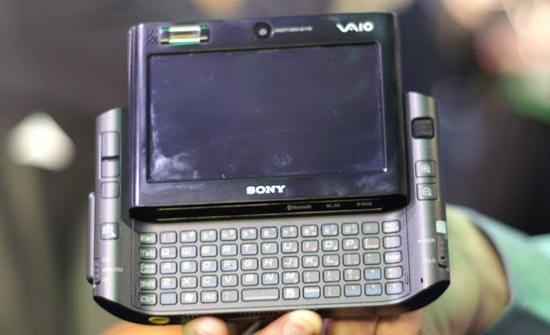CES 2007 Part I: Convergence Happened and the Most Impressive Demo of CES
by Anand Lal Shimpi on January 11, 2007 6:53 PM EST- Posted in
- Displays
Sony UMPC Update
After the UMPC craze of last year’s CES, Sony announced the first UMPC that had some potential - the Vaio UX. Featuring an integrated Blackberry-style keyboard, it looked like the UX could actually be useful, but in reality it was far from it. The keyboard ended up being more stylish than functional, and the screen was far too high res to actually be useful in the majority of cases. Furthermore, without good support for high DPI displays, Windows XP was the wrong OS to launch the UMPC with.

At this year’s CES, Sony announced an update to the Vaio UX which fixes some of the problems with the unit. Sony shaved down some of the area between the keys on the keyboard so you can actually get a better feel for the keys themselves, a major problem with the original unit. The keyboard is much improved but still not perfect, and in our opinion still more style than function. While Blackberry and other QWERTY-enabled smartphone owners can usually type pretty fast on their devices, Sony’s UMPC still isn’t quite there.

The major change to the updated model is the inclusion of a 32GB flash drive instead of a normal mechanical hard drive. The end result is that the unit is quicker to turn on and off, applications launch faster and the device is much more rugged. While we still think current UMPCs are missing the mark, Sony at least made their unit a little more attractive for those who were going to buy it anyways.










18 Comments
View All Comments
Johnmcl7 - Friday, January 12, 2007 - link
Can't say I agree with that, while LCDs are thin and light their image quality leaves a lot to be desired especially given the superior image quality of the CRTs they've effectively replaced.John
PrinceGaz - Sunday, January 14, 2007 - link
That very much depends on the type of LCD panel used. Maybe it's because my Mitsubishi 2070SB CRT display is about four years old and isn't as good as it used to be, but the overall image quality (including colour reproduction) of my new HP LP2065 which uses an S-IPS LCD panel is just as good as it. The response-time is also sufficiently fast that their is no visible blurring of fast moving images. And the 2070SB wasn't some cheapo CRT either, it was one of the best 20" visible CRT monitors you could get.The fact that the LP2065 was just a little over half the price of the old 2070SB actually makes modern LCD displays seem superior to CRTs, especially when the lower power consumption is factored in. It is also slightly (ahem!) less bulky and heavy than the old CRT monitor. It makes me wish I'd switched to an LCD sooner except of course that even a year or two ago, the picture quality of the best LCD panels wasn't anywhere near what it is today.
Give a *good* (in other words one that does not use a TN panel) LCD display a chance and you'll probably be surprised.
msva124 - Monday, January 15, 2007 - link
Does it scale well to different resolutions? I.E. for gaming.tumbleweed - Thursday, January 11, 2007 - link
"the display is superb, making it very similar to reading pages in a regular book"Hardly. It's dark grey on light grey, thus having less than stellar contrast. No, this really isn't similar to reading a regular book; it's similar to reading an ATM receipt. Once they get it to the point of true blank on something resembling white, then we can talk. Other than that, I'll admit it's nifty, but the display quality ain't there yet.
msva124 - Thursday, January 11, 2007 - link
OMG! It's almost as good as one as those CRT things that Nostradamus said would be here in the year 3000!GhandiInstinct - Thursday, January 11, 2007 - link
I AM SOLD ON OLED!!!!! Come get me!BladeVenom - Friday, January 12, 2007 - link
Last time I checked, OLED displays had a very short lifespan. That may be OK if you don't use it much, or like replacing your monitor every year, but I think many will have a problem with that.psychobriggsy - Friday, January 12, 2007 - link
They've even got blues up to >30k hours now. That's a lot of TV watching, although some people sure do like to watch TV all day.Anyway, I'm sure I read that these Sony displays used a single colour OLED throughout, with colour filters on top. White OLEDs can have very long lives. If they're using 100k hour OLEDs, and you have the TV on for 10 hours a day because you cannot bear the idea of not having it on, then that is 30 years before the display is ~half as bright as originally. I think that predicting television display technology in 2037 will be quite difficult.
I'm just hoping that one day OLEDs will actually really be available in large displays! Can't wait yet another 5 years...